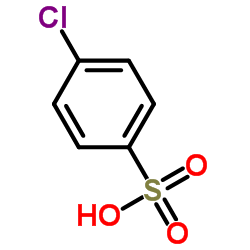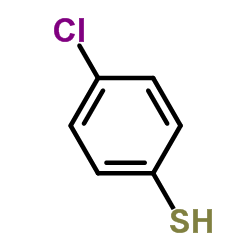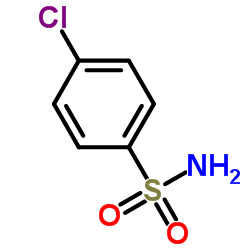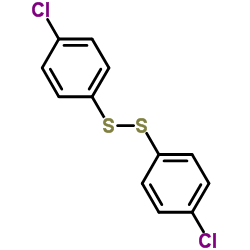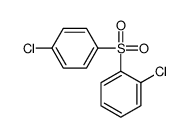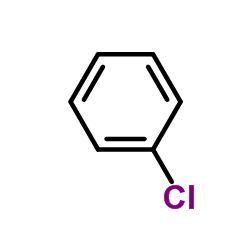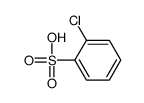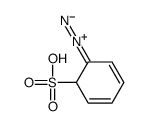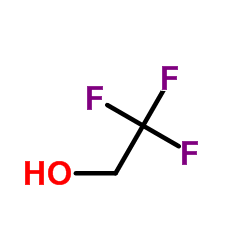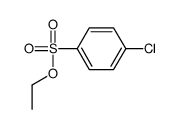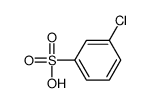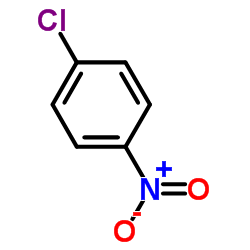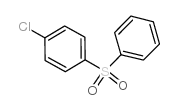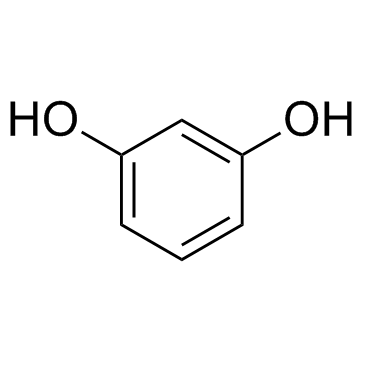98-66-8
| 中文名 | 4-氯苯磺酸 |
|---|---|
| 英文名 | 4-Chlorobenzenesulfonic acid |
| 中文别名 |
对氯苯磺酸
對氯苯磺酸 |
| 英文别名 |
4-CHLOROBENZENE SULPHONIC ACID
P-CHLOROPHENYLSULFONIC ACID 4-chlorobenzenesulphonic acid EINECS 202-690-0 MFCD00065342 4-Chlorobenzene sulfonic acid Benzenesulfonic acid, 4-chloro- 4-Chloro-benzenesulfonic acid Benzenesulfonic acid,p-chloro Benzenesulfonic acid, p-chloro- 4-chlorobenzene-1-sulfonic acid Benzenesulfonic acid,4-chloro p-Chlorobenzenesulfonic acid p-chlorobenzenesulphonic acid UNII:5CN6B87IK2 |
| 密度 | 1.6±0.1 g/cm3 |
|---|---|
| 沸点 | 258.6±0.0 °C at 760 mmHg |
| 熔点 | 102 °C |
| 分子式 | C6H5ClO3S |
| 分子量 | 192.620 |
| 闪点 | 108ºC |
| 精确质量 | 191.964798 |
| PSA | 62.75000 |
| LogP | 1.33 |
| 外观性状 | 淡灰色晶体 |
| 蒸汽压 | 0.0±0.5 mmHg at 25°C |
| 折射率 | 1.591 |
| 储存条件 | 存放于惰性气体之中;避免湿气 (吸湿) |
| 稳定性 | Stable. Incompatible with strong oxidizing agents. |
| 分子结构 | 1、 摩尔折射率:41.92 2、 摩尔体积(cm3/mol):124.1 3、 等张比容(90.2K):337.4 4、 表面张力(dyne/cm):54.5 5、 介电常数: 6、 偶极距(10-24cm3): 7、 极化率:16.62 |
| 计算化学 | 1、 疏水参数计算参考值(XlogP):0.6 2、 氢键供体数量:1 3、 氢键受体数量:3 4、 可旋转化学键数量:1 5、 互变异构体数量: 6、 拓扑分子极性表面积(TPSA):54.4 7、 重原子数量:11 8、 表面电荷:0 9、 复杂度:211 10、同位素原子数量:0 11、确定原子立构中心数量:0 12、不确定原子立构中心数量:0 13、确定化学键立构中心数量:0 14、不确定化学键立构中心数量:0 15、共价键单元数量:1 |
| 更多 | 1. 性状:针状结晶。 2. 密度(g/mL,25℃):未确定 3. 相对蒸汽密度(g/mL,空气=1):未确定 4. 熔点(ºC):102 5. 沸点(ºC,常压):未确定 6. 沸点(ºC, 22mmHg):149 7. 折射率:未确定 8. 闪点(ºC):未确定 9. 比旋光度(º):未确定 10. 自燃点或引燃温度(ºC): 未确定 11. 蒸气压(mmHg, 40ºC):未确定 12. 饱和蒸气压(kPa, ºC):未确定 13. 燃烧热(KJ/mol):未确定 14. 临界温度(ºC):未确定 15. 临界压力(KPa):未确定 16. 油水(辛醇/水)分配系数的对数值:未确定 17. 爆炸上限(%,V/V):未确定 18. 爆炸下限(%,V/V):未确定 19. 溶解性:溶于水和乙醇。 |
Synonym: Section 2 - COMPOSITION, INFORMATION ON INGREDIENTS
Risk Phrases: 22 34 Section 3 - HAZARDS IDENTIFICATION EMERGENCY OVERVIEW
Harmful if swallowed. Causes burns.Corrosive. Potential Health Effects Eye: Causes eye burns. May cause chemical conjunctivitis and corneal damage. Skin: Causes skin burns. May cause skin rash (in milder cases), and cold and clammy skin with cyanosis or pale color. Ingestion: May cause severe and permanent damage to the digestive tract. Causes gastrointestinal tract burns. May cause perforation of the digestive tract. May cause systemic effects. Inhalation: Causes chemical burns to the respiratory tract. Aspiration may lead to pulmonary edema. May cause systemic effects. Chronic: Effects may be delayed. Section 4 - FIRST AID MEASURES Eyes: Flush eyes with plenty of water for at least 15 minutes, occasionally lifting the upper and lower eyelids. Get medical aid immediately. Do NOT allow victim to rub eyes or keep eyes closed. Extensive irrigation with water is required (at least 30 minutes). Skin: Get medical aid. Immediately flush skin with plenty of water for at least 15 minutes while removing contaminated clothing and shoes. Wash clothing before reuse. Destroy contaminated shoes. Ingestion: Do not induce vomiting. If victim is conscious and alert, give 2-4 cupfuls of milk or water. Never give anything by mouth to an unconscious person. Get medical aid immediately. Inhalation: Get medical aid immediately. Remove from exposure and move to fresh air immediately. Do NOT use mouth-to-mouth resuscitation. If breathing has ceased apply artificial respiration using oxygen and a suitable mechanical device such as a bag and a mask. Notes to Physician: Section 5 - FIRE FIGHTING MEASURES General Information: As in any fire, wear a self-contained breathing apparatus in pressure-demand, MSHA/NIOSH (approved or equivalent), and full protective gear. During a fire, irritating and highly toxic gases may be generated by thermal decomposition or combustion. Extinguishing Media: Use agent most appropriate to extinguish fire. Section 6 - ACCIDENTAL RELEASE MEASURES General Information: Use proper personal protective equipment as indicated in Section 8. Spills/Leaks: Clean up spills immediately, observing precautions in the Protective Equipment section. Sweep up or absorb material, then place into a suitable clean, dry, closed container for disposal. Avoid generating dusty conditions. Provide ventilation. Section 7 - HANDLING and STORAGE Handling: Wash thoroughly after handling. Remove contaminated clothing and wash before reuse. Do not get in eyes, on skin, or on clothing. Keep container tightly closed. Do not ingest or inhale. Use with adequate ventilation. Discard contaminated shoes. Storage: Keep container closed when not in use. Store in a cool, dry, well-ventilated area away from incompatible substances. Corrosives area. Section 8 - EXPOSURE CONTROLS, PERSONAL PROTECTION Engineering Controls: Facilities storing or utilizing this material should be equipped with an eyewash facility and a safety shower. Use adequate ventilation to keep airborne concentrations low. Exposure Limits CAS# 98-66-8: Personal Protective Equipment Eyes: Wear appropriate protective eyeglasses or chemical safety goggles as described by OSHA's eye and face protection regulations in 29 CFR 1910.133 or European Standard EN166. Skin: Wear appropriate protective gloves to prevent skin exposure. Clothing: Wear appropriate protective clothing to minimize contact with skin. Respirators: A respiratory protection program that meets OSHA's 29 CFR 1910.134 and ANSI Z88.2 requirements or European Standard EN 149 must be followed whenever workplace conditions warrant respirator use. Section 9 - PHYSICAL AND CHEMICAL PROPERTIES Physical State: Flakes Color: gray-beige Odor: Not available. pH: Not available. Vapor Pressure: Not available. Viscosity: Not available. Boiling Point: Not available. Freezing/Melting Point: 102 deg C Autoignition Temperature: Not available. Flash Point: Not available. Explosion Limits, lower: Not available. Explosion Limits, upper: Not available. Decomposition Temperature: Solubility in water: Specific Gravity/Density: Molecular Formula: C6H5ClO3S Molecular Weight: 192.62 Section 10 - STABILITY AND REACTIVITY Chemical Stability: Stable under normal temperatures and pressures. Conditions to Avoid: Incompatible materials, dust generation, strong oxidants. Incompatibilities with Other Materials: Strong oxidizing agents. Hazardous Decomposition Products: Hydrogen chloride, carbon monoxide, irritating and toxic fumes and gases, carbon dioxide. Hazardous Polymerization: Has not been reported Section 11 - TOXICOLOGICAL INFORMATION RTECS#: CAS# 98-66-8: DB5074000 LD50/LC50: CAS# 98-66-8: Oral, rat: LD50 = >500 mg/kg. Carcinogenicity: 4-Chlorobenzenesulfonic acid (techn) - Not listed by ACGIH, IARC, or NTP. Other: See actual entry in RTECS for complete information. Section 12 - ECOLOGICAL INFORMATION Other No information available. Section 13 - DISPOSAL CONSIDERATIONS Dispose of in a manner consistent with federal, state, and local regulations. Section 14 - TRANSPORT INFORMATION IATA Shipping Name: ALKYLSULPHONIC ACIDS, SOLID Hazard Class: 8 UN Number: 2585 Packing Group: III IMO Shipping Name: ALKYLSULPHONIC ACIDS, SOLID Hazard Class: 8 UN Number: 2585 Packing Group: III RID/ADR Shipping Name: ALKYLSULPHONIC ACIDS, SOLID Hazard Class: 8 UN Number: 2585 Packing group: III Section 15 - REGULATORY INFORMATION European/International Regulations European Labeling in Accordance with EC Directives Hazard Symbols: C Risk Phrases: R 22 Harmful if swallowed. R 34 Causes burns. Safety Phrases: S 24/25 Avoid contact with skin and eyes. WGK (Water Danger/Protection) CAS# 98-66-8: No information available. Canada CAS# 98-66-8 is listed on Canada's NDSL List. CAS# 98-66-8 is not listed on Canada's Ingredient Disclosure List. US FEDERAL TSCA CAS# 98-66-8 is listed on the TSCA inventory. SECTION 16 - ADDITIONAL INFORMATION N/A |
|
毒理学数据: 急性毒性:大鼠经口LD50:>500mg /kg; CHEMICAL IDENTIFICATION
HEALTH HAZARD DATAACUTE TOXICITY DATA
|
| 符号 |


GHS05, GHS07 |
|---|---|
| 信号词 | Danger |
| 危害声明 | H302-H314 |
| 警示性声明 | P280-P305 + P351 + P338-P310 |
| 个人防护装备 | Eyeshields;Faceshields;full-face particle respirator type N100 (US);Gloves;respirator cartridge type N100 (US);type P1 (EN143) respirator filter;type P3 (EN 143) respirator cartridges |
| 危害码 (欧洲) | C:Corrosive; |
| 风险声明 (欧洲) | R22;R34 |
| 安全声明 (欧洲) | S26-S27-S28-S36/37/39-S45-S24/25 |
| 危险品运输编码 | UN 2583 8/PG 2 |
| WGK德国 | 3 |
| RTECS号 | DB5074000 |
| 包装等级 | III |
| 危险类别 | 8 |
| 海关编码 | 2904909090 |
| 上游产品 10 | |
|---|---|
| 下游产品 10 | |
| 海关编码 | 2904909090 |
|---|---|
| 中文概述 | 2904909090 其他烃的磺化、硝化、亚硝化衍生物(不论是否卤化). 增值税率:17.0% 退税率:9.0% 监管条件:无 最惠国关税:5.5% 普通关税:30.0% |
| 申报要素 | 品名, 成分含量, 用途 |
| Summary | HS:2904909090 sulphonated, nitrated or nitrosated derivatives of hydrocarbons, whether or not halogenated VAT:17.0% Tax rebate rate:9.0% Supervision conditions:none MFN tariff:5.5% General tariff:30.0% |


